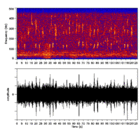- Acoustic Doppler Current Profiler
-
An Acoustic Doppler Current Profiler (ADCP or ADP) is a sonar that attempts to produce a record of water current velocities for a range of depths. They are made of ceramic materials, and contain transducers, an amplifier, a receiver, a mixer, an oscillator, a clock, a temperature sensor, a compass, a pitch and roll sensor, and computer components to save the information collected. ADCPs can be configured in many ways: side-listening, into rivers and canals for long term continuous discharge measurements, downward-listening and mounted on boats for instantaneous surveys in the ocean or rivers, and mounted on moorings, or the seabed for long term current & wave studies. They can stay underwater for years at a time, and have a battery back for an energy source. The sonar is used for oceanography, estuary, river and stream flow measurement, and weather forecasting.
Contents
Components
Depending on the field application, an ADCP may use one or more ceramics, (or other piezo materials) for transducers, which work in water similar to directional loudspeakers in air. These transducers are aimed such that the sound pulse travels through the water in different, but known directions. As the sound energy leaves and arrives at the transducer face it is shifted in frequency, known as the Doppler effect, by the relative velocity of the water. As that sound energy is returned (echo) by scatterers in the water the sound may also be shifted in frequency if there is relative velocity of water to scatterer. Trigonometry, averaging and some critical assumptions are used to calculate the velocity of the group of echoing scatters in a volume of water. By repetitive sampling of the return echo, and by "gating" the return data in time, the ADCP can produce a "profile" of water currents over a range of depths. Phased array techniques are also used to aim the sound (acoustic) energy, allowing for economical production of smaller ADCPs to accommodate a range of frequencies from 38 kHz to several megahertz.
In addition to the transducers, an ADCP typically has an electronic amplifier, receiver, mixer, oscillator, accurate clock, temperature sensor, compass, pitch and roll sensor, analog-to-digital converters, memory, digital signal processor and instruction set. The analog-to-digital converters (ADCs) and digital signal processor (DSP) are used to sample the returning signal, determine the Doppler shift, and sample the compass and other sensors in order to calculate range and a velocity vector relative to a known orientation.
Performance
There are a number of factors that affect accuracy, resolution and profile range. Most notable are: absorption, spreading, speed of sound in water, bandwidth of the sound energy, signal strength of the transmitted pulse and echo, size of transducer, beam width (sic) of the energy pulse travelling through the water, frequency, and a host of limitations associated with the signal processing techniques and hardware, including clock/oscillator accuracy.
ADCPs can be self-contained and operate from batteries for many years under the sea or remotely in a river or stream. Some time later they are retrieved and the historical current data is transferred from the ADCP memory to a computer and displayed using a variety of graphical and text-based software to observe the water current profiles. Or ADCPs can be connected to RS232, RS422, RS485, SDI-12, USB, Ethernet, Fiber, Modbus (SCADA) connections to provide real time, "live", monitoring of their output.
Uses
The ADCP, commercially available for about 25 years, is currently used for oceanography,[1] estuary, river and stream flow measurement, even in weather forecasting. ADCPs are used in diverse ways, from locating underwater "tornadoes" that might damage deep water oil drilling activity, to measuring water flow through sewer pipes, or hanging up side down under an iceberg and measuring the flow of freshwater melting off the iceberg. Some harbor managers now use ADCPs to help them take advantage of tides and currents and optimize the flow of shipping in a busy port.
An ADCP can also be an acoustic Doppler Velocity Log (DVL) if it is programmed with the correct signal processing logic. The DVL bounces sound off the bottom (or a reference layer of water) and can determine the velocity vector of a subsea vehicle (or surface vessel) moving across the sea floor. This information can be combined with a starting fix, compass heading, and acceleration sensors (typically by use of a Kalman Filter) to calculate the position of the vehicle. DVLs are used to help navigate surface vessels, submarines, autonomous underwater vehicles, and ROVs for precise positioning in an environment where GPS, and other navigational aids, don't work.
References
- ^ William J. Emery, Richard E. Thomson (2001). Data analysis methods in physical oceanography. Gulf Professional Publishing. p. 83. ISBN 9780444507570. http://books.google.com/books?id=A6ew-bJDIDIC&pg=PA83&lpg=PA83&dq=Acoustic+Doppler+Current+Profiler+book&source=bl&ots=PwSf29Bbuo&sig=LxTDjtmzKFVCgF8ZT0kwme964TU&hl=en&ei=WLtOTcSPFcP98Aaez9GCDw&sa=X&oi=book_result&ct=result&resnum=5&sqi=2&ved=0CDYQ6AEwBA#v=onepage&q=Acoustic%20Doppler%20Current%20Profiler%20book&f=false. Retrieved 2011-02-06.
Categories:
Wikimedia Foundation. 2010.



